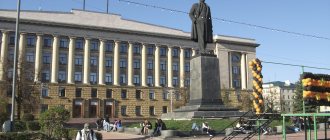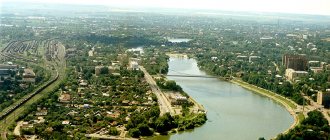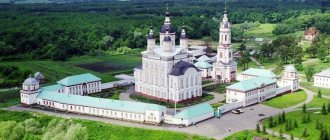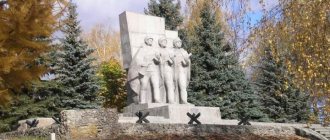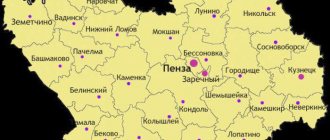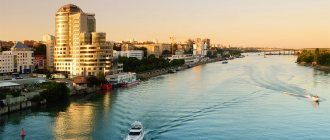Penza region is a subject of the Russian Federation. The region is located in the center of European Russia and is part of the Volga Federal District.
The administrative center of the region is the city of Penza.
It borders with the Ulyanovsk, Saratov, Tambov, Ryazan regions and the Republic of Mordovia.
The region was formed by the Decree of the Presidium of the Supreme Soviet of the USSR on February 4, 1939. The idea is being put forward to merge the Penza region and Mordovia into the Sursky Krai, with the center in Penza.
History of the region
Penza was founded in 1663 as a Russian fortress on the border of the Wild Field.
In 1719, the Penza province was formed as part of the Kazan province.
On September 15, 1780, the Penza province was formed, which existed until March 5, 1797, when the province was liquidated, and Penza became the district center of the Saratov province.
On September 9, 1801, the Penza province was restored and existed until 1928, the year of major administrative and territorial transformations in the USSR. In 1928, the province was liquidated, Penza became the center of the Penza district of the Middle Volga region, then the Kuibyshev region, and 9 years later (since 1937) - the regional center of the Tambov region.
On February 4, 1939, by decree of the Presidium of the Supreme Soviet of the USSR, the Tambov region was divided and the Penza region was formed, which exists to this day. In March 1939, the Penza Regional Committee of the All-Union Communist Party of Bolsheviks was created, and Alexander Kabanov became the first secretary of the regional committee.
When the Penza region was formed, it included: from the Tambov region - the city of Penza, Bashmakovsky, Bednodemyanovsky, Bessonovsky, Bolshe-Vyassky. Golitsynsky, Golovinshchinsky, Gorodishchensky, Zemetchinsky, Issinsky, Kamensky, Kerensky, Kondolsky, Luninsky, Mokshansky, Narovchatsky, Nizhne-Lomovsky, Pachelmsky, Poimsky, Svishchevsky, Sosedsky, Teleginsky, Ternovsky, Chembarsky and Shemysheysky districts; from the Kuibyshev region - Baranovsky, Kameshkirsky, Kuznetsky, Litvinovsky, Neverkinsky, Nikolaevsky, Nikolo-Pestrovsky districts; from the Saratov region - Bekovsky, Danilovsky, Kolyshleysky, Lopatinsky, Malo-Serdobinsky, Serdobsky, Tamalinsky districts. On January 19, 1943, Baranovsky and Nikolaevsky districts were transferred to the newly formed Ulyanovsk region.
Roller rink "Olympic"
Another place for speed lovers is the Olimpiysky roller rink, which is located on Gagarina Street, 6, building 1.
In this place you will be able not to part with your favorite skates in any weather, and experienced instructors will definitely teach those who want to master them. Often people come here to rollerblade with the whole family, because both pensioners and preschoolers can master it. It turns out it's simple and completely safe. In addition, this roller rink has a specially installed safety surface, so it is almost impossible to get seriously injured.
The area of the Olimpiysky roller rink is almost two thousand square meters, and the skating field itself is about 800 square meters. So 80 people can be here at the same time without interfering with each other.
“Olympic” in Penza is a unique platform where you can first go roller skating, then relax and refresh yourself in a cafe, and have an interesting and useful time with friends playing board games and game consoles. Until you get the strength to rollerblade again.
By the way, judging by the numerous reviews of regular visitors, this is a great place to have fun celebrating your birthday.
Geography
The Penza region is located between 42° and 47° east longitude and between 54° and 52° north latitude.
- The length from west to east is 330 km.
- The length from north to south is 204 km.
- Area - 43.2 thousand km².
- The highest point in the territory is 342.037 m above sea level.
- The lowest point in the territory is 97.6 m above sea level.
The geographical center of the Penza region has coordinates 53°10'north latitude and 44°34'east longitude. The Penza region lies in a temperate geographical zone, at the junction of forest, forest-steppe and steppe natural zones.
The surface relief is flat, slightly hilly. The extreme west of the region belongs to the eastern edge of the Oka-Don Plain.
Hydrography
There are over 3,000 rivers and streams in the region with a total length of 15,458 km. The largest of the rivers - Sura, Moksha - belong to the endorheic basin of the Caspian Sea (Volga River); Khoper, Vorona (drainage basin of the Don River). The Penza River, a tributary of the Sura, gave its name to the regional center.
Protection of Nature
State Nature Reserve "Volga Forest-Steppe". The total area of the reserve is 8373 hectares. It contains thick chernozems, unique for the forest-steppe zone; steppe plant complexes have not been preserved anywhere else in Europe. It is distinguished by its unusual floristic richness and the presence of rare species of plants and animals listed in the Red Book. More than 860 species of vascular plants, more than 100 species of lichens, more than 70 species of bryophytes and about 120 species of fungi grow on its territory.
Flora
Natural vegetation has been preserved on about a third of the territory of the Penza region; forests occupy almost 20% of its area. The importance of forests is not so much industrial as they are water protection, soil protection and recreational. The steppes are mostly plowed.
There are about 1,500 species of higher plants on the territory of the Penza region.
The list of rare and endangered species in the Red Data Book of the Penza Region includes 156 species of vascular plants and 40 species of fungi.
On the territory of the Privolzhskaya Forest-Steppe Nature Reserve grows more than 860 species of vascular plants (over 55% of the species composition of the flora of the Penza region and 40% of the flora of the Middle Volga region), 108 species of lichens, 72 species of bryophytes and 119 species of fungi.
Fauna
The region is home to 316 species of vertebrates.
There are about 50 species of fish in the reservoirs of the Penza region. The largest, the Sursky Reservoir, has about 30 species. In total, 10 species of fish are listed in the region’s Red Book.
Minerals
The mineral resource base of the region consists mainly of raw materials for the construction industry. The region contains deposits of clays (including refractory and refractory), gypsum, glass sands, marl and chalk, opoka, coarse-grained molding sands, mineral pigments, limestone, diatomites, glauconites, as well as small accumulations of phosphorites suitable for grinding under phosphorite flour. Three oil fields have been explored in the region: Verkhozimskoye, Komarovskoye and Alekseevskoye, and there are peat deposits. Ore occurrences of titanium-zirconium placers have been identified.
What are the Penza surroundings famous for?
At first glance, Penza is similar to many other Russian cities; upon closer inspection, it reveals an unexpected side, in it:
- neighborhoods of historical buildings have been preserved;
- the pages of history and the spirit of a particular era are woven together;
- The streets are decorated with fancy sculptures.
One of the central streets of the regional center is named Kirov. It originates from the square named after M.Yu. Lermontov. The creation of this green zone is associated with the name of Alexander II.
The emperor, having visited the site of the founding of the city, instead of a fortress, saw ruins overgrown with weeds, was very dissatisfied, and proposed creating a public garden. The mayors hastily implemented the royal lady’s proposal by decorating the central alley with a bust of the poet.
If you walk along Kirov Street, you can see many houses of “merchant Penza” and:
- monument to Lermontov;
- defensive rampart with part of the fortress palisade;
a monument to the first settler, opened in the year of the celebration of the six hundredth anniversary of the Battle of Kulikovo. It was erected in memory of the military exploits of those who guarded the borders in the southeast and worked on the land in peacetime; several Orthodox white-stone Shrines of the 17th century: Trinity Convent, Church of the Descent of the Holy Spirit;
Glory Square.
The Square of Glory intersects with the main Lenin Square. It leads to a favorite place for relaxation, leisurely walks, dates - to the Embankment, where Rostock rises.
This 25-meter monument serves as a reminder of the continuous growth of all spheres of life in the city, and is considered one of the city’s calling cards, where newlyweds and tourists come.
According to a recently created tradition, lovers leave a castle behind the stele as a sign of eternal love. Nearby there is a granite building, in which a message to descendants was hidden back in 1967. According to the will, it will be opened in 2021.
Nearby is the best engineering structure of Soviet times: the suspension pedestrian bridge of Friendship, also a favorite place for newlyweds, tourists, and those who want to take spectacular photographs.
In Penza, they pay great attention to preserving the “lungs of the city”: it was decided to add more to the seven parks and five forested areas. In 2015, according to a resolution of the City Duma, a public garden with an area of at least 50 acres must be in every district
In the summer of 2016, three new green areas were laid out, it was planned to improve the Arbekovsky ponds, the embankment, and install new sculptural compositions
In 2015, according to a resolution of the City Duma, a public garden with an area of at least 50 acres must be in every district. In the summer of 2016, three new green areas were laid out, improvements to the Arbekovsky ponds and embankment, and installation of new sculptural compositions were planned.
Penza residents love to decorate the streets with fancy sculptures; while walking, be sure to look around so as not to miss a historical monument or an unusual stone figure.
There are more than two dozen of them in the city. Find:
- A traffic light tree in a park near the train station. The ideological author of this art object was the mayor of the city, inspired by a trip to London. Having seen a similar monument in England, he decided to create a miniature copy in the regional center, just as traffic lights were being changed on the streets. The old ones (36 pieces in total) were connected together, creating an installation that decorates and illuminates the alleys;
- a monument to a jeweler on Moskovskaya Street, a belief is associated with it that it unites young people (if a ring is placed on their finger) and fulfills wishes;
- The monument to policemen, which appeared in 2007, is the only one in Russia. The sculpture has a prototype: this is the Penza district police officer G. Shelkov, who became famous throughout the city;
- sculptural compositions of a family and a Lady with a dog on Volodarsky Street;
The most famous tourist places in the world: photos, descriptions and much more - here.
Angel of Peace on Zhukov Square. Penza became the twenty-third city under the protection of the bronze angel.
wartime monuments: on Victory Square, on Tukhachevsky, K. Marx, Leningradskaya streets, samples of military equipment are installed on the square. Zhukov, in front of the Museum of Local Lore.
Attractions
- The main tourist attraction of the Penza region is the State Tarkhany Museum-Reserve - an estate of the late 18th - early 19th centuries, in which the poet Mikhail Yuryevich Lermontov spent his childhood.
- On the territory of the Chistye Prudy recreational complex near Ramsay there is the Legend sculpture park, famous for the annual holding of international sculpture symposiums. The Legend Park has 275 unique works of marble, granite, wood, metal, bronze, made by 178 sculptors from 59 countries.
Nikolsky Museum of Glass and Crystal
Nikolsky Museum of Glass and Crystal
Nikolsky district
In 1789, at the crystal factory of Alexei Bakhmetev in the city of Nikolskoye, a special storeroom was opened, which was also called the model room. The best products were stored there and then displayed at exhibitions.
In 1884, the plant was inherited by Prince Alexander Obolensky, a distant relative of the Bakhmetevs. The new owner replenished the museum collection with samples of foreign glass. Obolensky also brought to the storeroom decanters found at archaeological excavations in Kerch, which were made in the 1st century AD.
After the revolution, the plant was nationalized and renamed “Red Giant”, and the museum continued its work. His collection included products from Soviet glassmakers. In 1990, a new two-story building was built especially for the museum, which now houses the main exhibition.
Today the museum exhibits one of the largest collections of glass products in Russia, which includes over 14 thousand exhibits. Among them are cups that the factory produced in the 1750s by order of Catherine II, medallions depicting heroes of the Patriotic War of 1812, and a crystal table of Joseph Stalin.
Weather in Penza by months:
| Month | Temperature | Cloudiness | Rainy days/Amount of precipitation | Number of sunshine hours per day | |
| During the day | At night | ||||
| January | -8.2°C | -10.9°C | 83.0% | 3 days (42.3 mm.) | 8h. 11m. |
| February | -6.5°C | -10.7°C | 82.7% | 2 days (30.9 mm.) | 9 o'clock 51m. |
| March | -1.8°C | -6.7°C | 80.1% | 3 days (41.2 mm.) | 11 o'clock 53m. |
| April | 9.6°C | 3.1°C | 54.0% | 3 days (46.9 mm.) | 14h. 0m. |
| May | 20.3°C | 11.1°C | 36.4% | 4 days (44.4 mm.) | 15h. 52m. |
| June | 23.0°C | 13.9°C | 33.5% | 5 days (62.6 mm.) | 16h. 53m. |
| July | 25.9°C | 15.9°C | 31.8% | 5 days (63.4 mm.) | 16h. 23m. |
| August | 24.5°C | 15.0°C | 29.2% | 4 days (46.2 mm.) | 14h. 43m. |
| September | 16.5°C | 9.6°C | 44.0% | 4 days (52.3 mm.) | 12h. 40m. |
| October | 8.0°C | 3.9°C | 57.3% | 3 days (42.9 mm.) | 10 o'clock 35m. |
| November | 0.4°C | -2.1°C | 61.8% | 2 days (34.0 mm.) | 8h. 41m. |
| December | -4.1°C | -6.0°C | 82.3% | 3 days (39.1 mm.) | 7h. 38m. |
*This table displays weather averages collected over more than three years
TOURIST REVIEWS:
Walking areas in the city center
As in many Russian cities, the city center is of greatest value from a traveler's point of view. Everything else is residential areas, where, it seems to me, there is nothing interesting. At least I can speak for myself. With each new trip I try to find information about where it would be worth going, what to see, where to take a walk, but so far I haven’t found anything interesting for myself.
There are several places for walking in the city center that we have identified for ourselves. These include the pedestrian Moskovskaya Street, the Sura River embankment and the Central Park of Culture and Leisure.
Moscow street
It is a spacious pedestrian zone, along which on the ground floors of buildings there are many cafes (including our favorite “Madrid”, where you can eat well for little money) and shops (mainly with clothes and shoes). On the same central street there is a square with the White House, as well as a square with the only fountain in the city (at least I haven’t seen any others). Moreover, the fountain itself has remained here since Soviet times and looks terrible. But on the same square with the fountain there are two attractions - a cuckoo clock and a panel of their beer caps. Well, on the end of one of the buildings there is a huge thermometer that has not been working for a long time. Do you think this characterizes the city?
Embankment
attracts mainly local residents, since in the summer in the shade of trees you can walk there with children or sit with a group. And without fail, all newlyweds in the city come here to hang a lock on the railing and take pictures near the Strela. By the way, only this year I noticed that the newlyweds have nowhere to hang the locks on the table, so they are cut down. And to add more romance to the action, a love tree was installed a little further from the stele, where hanging locks is doubly pleasant.
Let me also note that Moskovskaya Street is connected to the embankment by an alley with benches and flower beds of various types and shapes on both sides. It's a nice place, I must say. Tired from walking, we sat down there to rest. One of the flower beds is made in the form of a wicker car, on the other the name of the city and the year of its foundation are laid out in flowers, etc.
Well, the main entertainment for us so far is the park
. It concentrates the main entertainment life for families with small children. There are attractions for every taste, ice cream, a cafe, and children's animation on weekends. True, what surprised me was that the entrance to the playground is paid. In our city, such entertainment is in general use and completely free. Well, as they say, you don’t go to someone else’s monastery with your samovar. I had to pay 50 rubles for each child (and for the youngest, who is 1.5 years old, since he did not want to sit in a stroller, but wanted to swing on a swing and slide down a tiny slide). The second disappointment was the lack of any fountain in the park. Therefore, it took a long time to wipe the children off the sand with wet wipes. In general, as we understand, there is tension with fountains in Penza.
Leaving the park this time, we accidentally noticed the entrance to the botanical garden. But we were already getting ready to leave, so we didn’t have time to take a walk there. But for the future we made a tick for ourselves that next time we will go there for a walk and see what it is like. There is also an entrance fee.
Excursions in Penza
What should those who don’t know where to go in Penza do? Of course, choose one of the many excursion programs that the city generously offers to its guests.
- "Memorable places of Penza." This program is ideal for people new to the city. Participants will be able to see the most interesting places of the settlement, learn more about its architecture and history.
- "Due to raids." The fortress city once served as a kind of border point, protecting the country from attacks by its closest neighbors. Those who are interested in events of the distant past and hot battles should definitely visit this excursion.
- "Literary Penza". This program will appeal to those who love to read. Many famous writers were born and raised in Penza.
- "Secrets of old Penza." Tourists who like to listen to ancient legends should definitely choose this program. They will learn how many secrets the picturesque city, located on the banks of the river, holds. Mysterious kidnappings, bandits in labyrinths, underground treasures, voices from underground - participants will learn many shocking facts.
- "The Road to the Temple" This program is popular among tourists who want to learn more about religious buildings located in Penza.
Of course, this is just part of the exciting programs.
"Mug of beer"
In the center of Penza on Fontannaya Square there is a unique landmark of the city - the “Mug of Beer” panel. It took 55 thousand beer caps to create a reproduction of the famous painting by Edouard Manet depicting a serious elderly gentleman with a mug of beer in one hand and a smoking pipe in the other. The panel was donated to the city by a local brewing company. It was opened in 2000.


